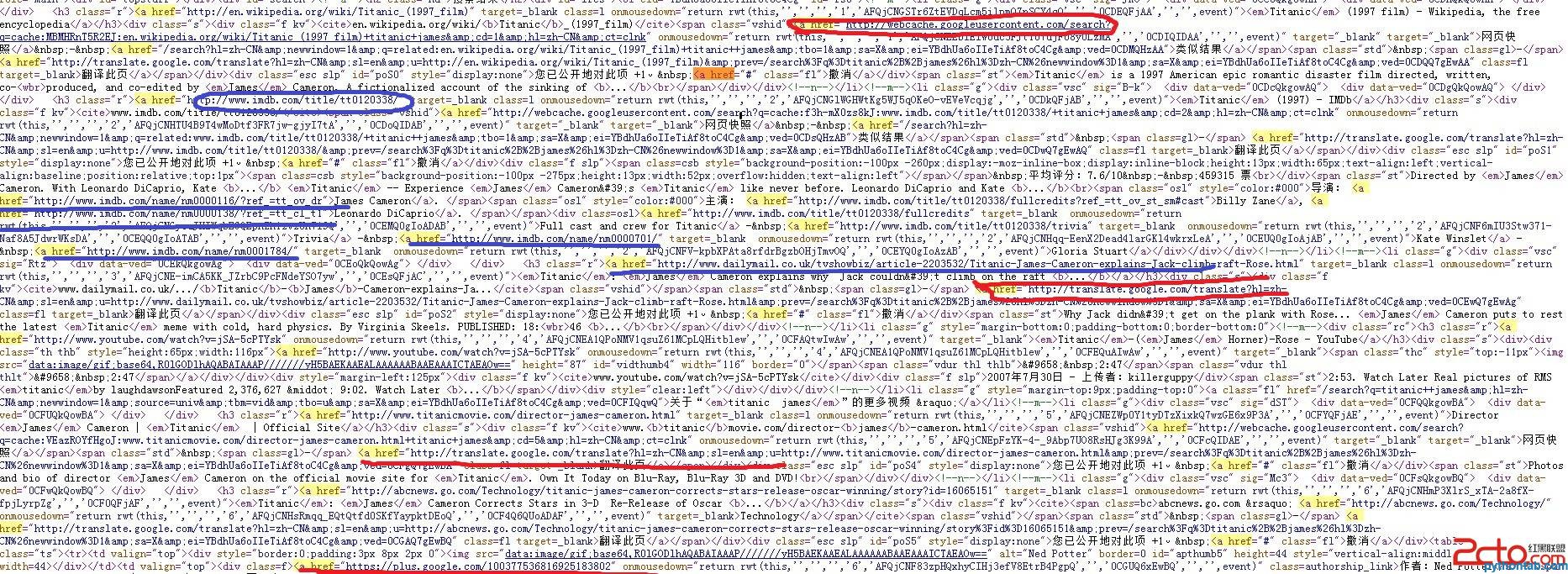1)urllib2+BeautifulSoup抓取Goolge搜索链接
近期,参与的项目需要对Google搜索结果进行处理,之前学习了Python处理网页相关的工具。实际应用中,使用了urllib2和beautifulsoup来进行网页的抓取,但是在抓取google搜索结果的时候,发现如果是直接对google搜索结果页面的源代码进行处理,会得到很多“脏”链接。
看下图为搜索“titanic james”的结果:

图中红色标记的是不需要的,蓝色标记的是需要抓取处理的。
这种“脏链接”当然可以通过规则过滤的方法来过滤掉,但是这样程序的复杂度就高了。正当自己愁眉苦脸的正在写过滤规则时。同学提醒说google应该提供相关的api,才恍然大明白。
(2)Google Web Search API+多线程
文档中给出使用Python进行搜索的例子:
图中红色标记的是不需要的,蓝色标记的是需要抓取处理的。
这种“脏链接”当然可以通过规则过滤的方法来过滤掉,但是这样程序的复杂度就高了。正当自己愁眉苦脸的正在写过滤规则时。同学提醒说google应该提供相关的api,才恍然大明白。
(2)Google Web Search API+多线程
文档中给出使用Python进行搜索的例子:
import simplejson
# The request also includes the userip parameter which provides the end
# user's IP address. Doing so will help distinguish this legitimate
# server-side traffic from traffic which doesn't come from an end-user.
url = ('https://ajax.googleapis.com/ajax/services/search/web'
'?v=1.0&q=Paris%20Hilton&userip=USERS-IP-ADDRESS')
request = urllib2.Request(
url, None, {'Referer': /* Enter the URL of your site here */})
response = urllib2.urlopen(request)
# Process the JSON string.
results = simplejson.load(response)
# now have some fun with the results...
import simplejson
# The request also includes the userip parameter which provides the end
# user's IP address. Doing so will help distinguish this legitimate
# server-side traffic from traffic which doesn't come from an end-user.
url = ('https://ajax.googleapis.com/ajax/services/search/web'
'?v=1.0&q=Paris%20Hilton&userip=USERS-IP-ADDRESS')
request = urllib2.Request(
url, None, {'Referer': /* Enter the URL of your site here */})
response = urllib2.urlopen(request)
# Process the JSON string.
results = simplejson.load(response)
# now have some fun with the results..实际应用中可能需要抓取google的很多网页,所以还需要使用多线程来分担抓取任务。使用google web search api的参考详细介绍,请看此处(这里介绍了Standard URL Arguments)。另外要特别注意,url中参数rsz必须是8(包括8)以下的值,若大于8,会报错的!
(3)代码实现
代码实现还存在问题,但是能够运行,鲁棒性差,还需要进行改进,希望各路大神指出错误(初学Python),不胜感激。
#-*-coding:utf-8-*-
import urllib2,urllib
import simplejson
import os, time,threading
import common, html_filter
#input the keywords
keywords = raw_input('Enter the keywords: ')
#define rnum_perpage, pages
rnum_perpage=8
pages=8
#定义线程函数
def thread_scratch(url, rnum_perpage, page):
url_set = []
try:
request = urllib2.Request(url, None, {'Referer': 'http://www.sina.com'})
response = urllib2.urlopen(request)
# Process the JSON string.
results = simplejson.load(response)
info = results['responseData']['results']
except Exception,e:
print 'error occured'
print e
else:
for minfo in info:
url_set.append(minfo['url'])
print minfo['url']
#处理链接
i = 0
for u in url_set:
try:
request_url = urllib2.Request(u, None, {'Referer': 'http://www.sina.com'})
request_url.add_header(
'User-agent',
'CSC'
)
response_data = urllib2.urlopen(request_url).read()
#过滤文件
#content_data = html_filter.filter_tags(response_data)
#写入文件
filenum = i+page
filename = dir_name+'/related_html_'+str(filenum)
print ' write start: related_html_'+str(filenum)
f = open(filename, 'w+', -1)
f.write(response_data)
#print content_data
f.close()
print ' write down: related_html_'+str(filenum)
except Exception, e:
print 'error occured 2'
print e
i = i+1
return
#创建文件夹
dir_name = 'related_html_'+urllib.quote(keywords)
if os.path.exists(dir_name):
print 'exists file'
common.delete_dir_or_file(dir_name)
os.makedirs(dir_name)
#抓取网页
print 'start to scratch web pages:'
for x in range(pages):
print "page:%s"%(x+1)
page = x * rnum_perpage
url = ('https://ajax.googleapis.com/ajax/services/search/web'
'?v=1.0&q=%s&rsz=%s&start=%s') % (urllib.quote(keywords), rnum_perpage,page)
print url
t = threading.Thread(target=thread_scratch, args=(url,rnum_perpage, page))
t.start()
#主线程等待子线程抓取完
main_thread = threading.currentThread()
for t in threading.enumerate():
if t is main_thread:
continue
t.join() 了解差异:用于循环和python中的循环May 16, 2025 am 12:17 AM
了解差异:用于循环和python中的循环May 16, 2025 am 12:17 AMtheDifferenceBetweewneaforoopandawhileLoopInpythonisthataThataThataThataThataThataThataNumberoFiterationSiskNownInAdvance,而leleawhileLoopisusedWhenaconDitionNeedneedneedneedNeedStobeCheckedStobeCheckedStobeCheckedStobeCheckedStobeceDrepeTysepectients.peatsiveSectlyStheStobeCeptellyWithnumberofiterations.1)forloopsareAceareIdealForitoringercortersence
 Python循环控制:对于vs -a -a比较May 16, 2025 am 12:16 AM
Python循环控制:对于vs -a -a比较May 16, 2025 am 12:16 AM在Python中,for循环适用于已知迭代次数的情况,而while循环适合未知迭代次数且需要更多控制的情况。1)for循环适用于遍历序列,如列表、字符串等,代码简洁且Pythonic。2)while循环在需要根据条件控制循环或等待用户输入时更合适,但需注意避免无限循环。3)性能上,for循环略快,但差异通常不大。选择合适的循环类型可以提高代码的效率和可读性。
 如何在Python中结合两个列表:5种简单的方法May 16, 2025 am 12:16 AM
如何在Python中结合两个列表:5种简单的方法May 16, 2025 am 12:16 AM在Python中,可以通过五种方法合并列表:1)使用 运算符,简单直观,适用于小列表;2)使用extend()方法,直接修改原列表,适用于需要频繁更新的列表;3)使用列表解析式,简洁且可对元素进行操作;4)使用itertools.chain()函数,内存高效,适合大数据集;5)使用*运算符和zip()函数,适用于需要配对元素的场景。每种方法都有其特定用途和优缺点,选择时应考虑项目需求和性能。
 循环时循环:python语法,用例和示例May 16, 2025 am 12:14 AM
循环时循环:python语法,用例和示例May 16, 2025 am 12:14 AMforoopsare whenthenemberofiterationsisknown,而whileLoopsareUseduntilacTitionismet.1)ForloopSareIdealForeSequencesLikeLists,UsingSyntaxLike'forfruitinFruitinFruitinFruitIts:print(fruit)'。2)'
 python串联列表列表May 16, 2025 am 12:08 AM
python串联列表列表May 16, 2025 am 12:08 AMtoConcateNateAlistofListsInpython,useextend,listComprehensions,itertools.Chain,orrecursiveFunctions.1)ExtendMethodStraightForwardButverBose.2)listComprechencomprechensionsareconconconciseandemandeconeandefforlargerdatasets.3)
 Python中的合并列表:选择正确的方法May 14, 2025 am 12:11 AM
Python中的合并列表:选择正确的方法May 14, 2025 am 12:11 AMTomergelistsinpython,YouCanusethe操作员,estextMethod,ListComprehension,Oritertools
 如何在Python 3中加入两个列表?May 14, 2025 am 12:09 AM
如何在Python 3中加入两个列表?May 14, 2025 am 12:09 AM在Python3中,可以通过多种方法连接两个列表:1)使用 运算符,适用于小列表,但对大列表效率低;2)使用extend方法,适用于大列表,内存效率高,但会修改原列表;3)使用*运算符,适用于合并多个列表,不修改原列表;4)使用itertools.chain,适用于大数据集,内存效率高。
 Python串联列表字符串May 14, 2025 am 12:08 AM
Python串联列表字符串May 14, 2025 am 12:08 AM使用join()方法是Python中从列表连接字符串最有效的方法。1)使用join()方法高效且易读。2)循环使用 运算符对大列表效率低。3)列表推导式与join()结合适用于需要转换的场景。4)reduce()方法适用于其他类型归约,但对字符串连接效率低。完整句子结束。


热AI工具

Undresser.AI Undress
人工智能驱动的应用程序,用于创建逼真的裸体照片

AI Clothes Remover
用于从照片中去除衣服的在线人工智能工具。

Undress AI Tool
免费脱衣服图片

Clothoff.io
AI脱衣机

Video Face Swap
使用我们完全免费的人工智能换脸工具轻松在任何视频中换脸!

热门文章

热工具

ZendStudio 13.5.1 Mac
功能强大的PHP集成开发环境

SecLists
SecLists是最终安全测试人员的伙伴。它是一个包含各种类型列表的集合,这些列表在安全评估过程中经常使用,都在一个地方。SecLists通过方便地提供安全测试人员可能需要的所有列表,帮助提高安全测试的效率和生产力。列表类型包括用户名、密码、URL、模糊测试有效载荷、敏感数据模式、Web shell等等。测试人员只需将此存储库拉到新的测试机上,他就可以访问到所需的每种类型的列表。

Atom编辑器mac版下载
最流行的的开源编辑器

MinGW - 适用于 Windows 的极简 GNU
这个项目正在迁移到osdn.net/projects/mingw的过程中,你可以继续在那里关注我们。MinGW:GNU编译器集合(GCC)的本地Windows移植版本,可自由分发的导入库和用于构建本地Windows应用程序的头文件;包括对MSVC运行时的扩展,以支持C99功能。MinGW的所有软件都可以在64位Windows平台上运行。

螳螂BT
Mantis是一个易于部署的基于Web的缺陷跟踪工具,用于帮助产品缺陷跟踪。它需要PHP、MySQL和一个Web服务器。请查看我们的演示和托管服务。





